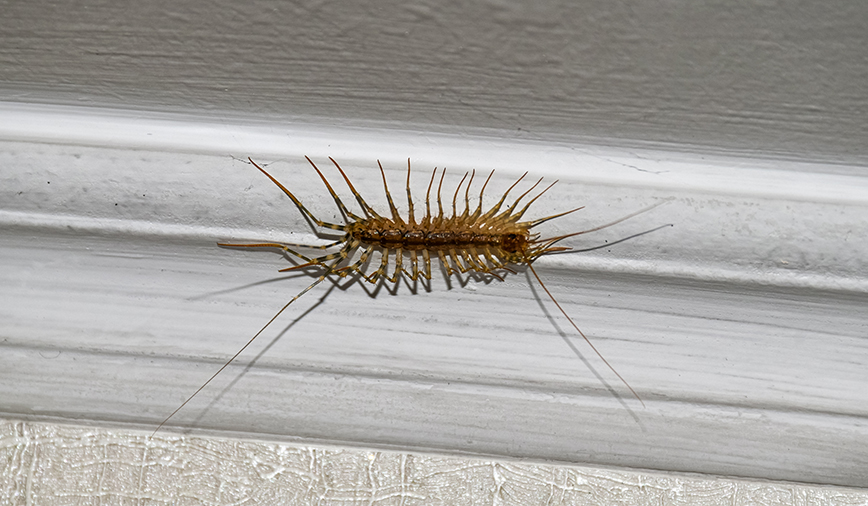Pam’s Perspective
From the…
Pam Otto is the Manager of Natural Programs and Interpretive Services for the St. Charles Park District
September 13, 2013
It was an “Eek!” heard round the world. Or at least in every corner of our humble campus abode. My college roommate Alisan, one of three people I shared the apartment with, had uncorked the shriek, the likes of which I hadn’t heard since my box turtle Arthur crawled over her bare foot during finals week of fall semester 1982.
This, however, was spring of 1984. The four of us were living in a swanky two-bedroom, shag-carpeted unit that overlooked a small creek (“the Boneyard,” for any of you University of Illinois grads). Dark and somewhat damp, the apartment was home to all manner of crawly things, especially cockroaches.
We all knew Al’s cockroach squeal, which really was more of a muffled “Aak!” than a full-blown “Eek!” But this startling outburst was way more chilling. It was the sort of scream reserved for life’s truly menacing pests: the mouse, the spider…and the house centipede, Scutigera coleoptrata.
You know the sort of many-legged creature I’m talking about. Yellowish tan, usually with vague longitudinal stripes, these are the critters people usually describe as having “a million legs” and moving “a thousand miles an hour.” They frequently appear in sinks and tubs, but also can be found traipsing across walls, ceilings, baseboards and – in Al’s case, rather disconcertingly – a pile of freshly laundered delicates.
I’m reminded of Al’s centipede scream every time I see a house centipede, which is fairly often. These successful myriapods, native to (most likely) the Mediterranean region, have been introduced across the United States and southern Canada. Though they are sensitive to cold temperatures, they’ve found a perfect habitat inside our climate-controlled homes, where they enjoy year-round comfort as well as an abundance of food.
This is where I’ll probably lose some of you, because what I’m about to do now is stick up for these wiggly
squigglers. True, they’re neither cute nor handsome, and the way they move is, well, downright creepy. But house centipedes are, like fly swatters and ant traps, handy to have around.
So long as they can avoid ending up on the business end of a shoe, a tissue or – my friend Barb’s preferred means, a stream of hairspray – house centipedes will work diligently to reduce your home’s populations of a wide array of even less savory characters. Fierce predators, house centipedes use modified forelegs to inject venom and take down a wide variety of prey, including cockroach nymphs, carpet beetle larvae, bedbugs, silverfish, crickets and earwigs, plus all manner of bite-sized flies and moths.
No one knows exactly when they showed up, but house centipedes have shared our living spaces here in the U.S. for at least a century and a half.
By the early 1900s they were established enough to earn their own United States Department of Agriculture publication: Circular No. 48, The House Centipede. Entomologists of the time wrote, “It may often be seen darting across floors with very great speed, occasionally stopping suddenly and remaining absolutely motionless, presently to resume its rapid movements, often darting directly at inmates of the house, particularly women, evidently with a desire to conceal itself beneath their dresses, and thus creating much consternation.”
The next time you or one of your “inmates” spots a house centipede, take a moment to take a look at its many fine traits. Adults have 15 pairs of legs, neatly marked in tweedy tans and browns. Larvae, however, start out with only four pairs, adding more as they molt and mature.
The final pair of legs on mature house centipedes actually function as sensory organs, much like the antennae at the front of the animal. This added input helps house centipedes hunt with deadly accuracy; it’s also useful when they go on the prowl for mates.
Given favorable conditions—moisture, warmth, plenty of prey and tolerant inmates—house centipedes will take full advantage and reproduce with regularity. Females are capable of laying 35 to 150 eggs each breeding cycle, year after year.
Yep, you read correctly. Years, plural. House centipedes can be astoundingly long-lived. Estimates range from three to seven years, a span I’m sure you’ll agree is Eek!straordinary.
Pam Otto is the manager of nature programs and interpretive services at the Hickory Knolls Discovery Center, a facility of the St. Charles Park District. She can be reached at potto@stcparks.org or 630-513-4346.

